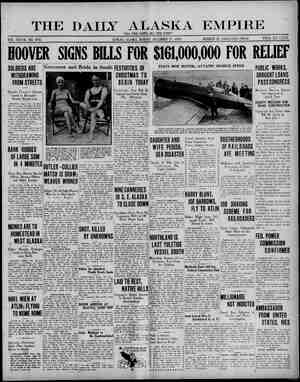Evening Star Newspaper, December 21, 1930, Page 92
You have reached the hourly page view limit. Unlock higher limit to our entire archive!
Subscribers enjoy higher page view limit, downloads, and exclusive features.
THE SUNDAY SWAR, WASHINGTON, D. C, —— DECEMBER 21, 1930. Old Masters Made Christmas Story Popular - Remarkable Original Engravings in Library of Congress Come Down From Fifteenth and Sixteenth Centuries —The Master Engravers of 0ld Days—Prints Have Been Telling the Christmas Story for Four Hundred Years. BY DOROTHY FLETCHER. EHOLD there came wise men from the East...” And with these suagic werds the Christmas story was started on its way down through the centuries— in legind, music, sculpture, painting and en- 3 . When the Christ Child appeared, the 66 and engravers and architects have work on masterpieces that tell the stery Nativity, the Adoration of the Shepherds Adoration of the Wise Men and the Flig! nence of great works of art that portray Christmas story far better than historians ever coulld early church. Many careless writers, whose sentiment of what ought to be is stronger than of what really is have spoken tian art. But in fact it does mot appear any form until the fourth century; it is repre- semted less frequently than many other sub- jécts from the Old and New Testaments; end it does not really assume a prominent and central place in art until the thirteenth cen- tury™ Legend has it that St. Luke painted the not until the thirteenth century that Cimabue, “the Father of Italian painting,” in executing his inspirational altar-piece, “Madonna and Child,” threw off the stiff Byzantine influence and paved the way fTer more graceful de- lineations of the Christmas stery. AJID from Cimsbue down te the present day, the art world has never tired of re- peating, from various peints of wview, the story of the Nativity, Eurepe's galleries and churches are filled with the pictured Christmas story— with Murillo's “Madonna and Child,” Rubens’ colorful . “Visitation of the Kings,” Raphael's exquisite “Sistine Madonna,” Rembrandt's f she Mogi™ M Sugresiag v in 24305 Luons Van - i et o for taking impressions on paper befere the lucky Florentine goldsmith's time. “This was the epoch as important to art as the discovery of printing was to knowledge,” according to Frederick Keppel, “and both for the same seasem, for now impressions from plates, like impressions from type, could be multiplied and diffused without limit.” Fifteenth and sixteenth century German and Dutch artists began to do in emgraving and etching what a number of Europe’s best paint- ers had done in their canvases. They captured and permanently set forth the spirit of the Nativity in an arresting manner. That meant that art was reaching a larger audience than ever ‘before. The engravings eof these old masters take on added interest ‘because etching is the mest widely spread and pepular art in America today and has been for ‘the past century. At the Library of Congress one may see both original engravings and beautiful reproductions e b it : £ - o “The Adoration of the Magi.” engraving made in 1511 by Albrecht of original prints made by fifteenth and six- teenth century master-engravers. Happily, pre- dominant among these rare prints are delinea- est engravers the world has ever known. In those days the great alm of the artist was to induce piety in the spectator rather than to make a pleasing picture. Of course, the great Ummmmumm for a picture of the Nativity was practi- cally figed. The mother lies beside tite manger , @& Germon whe lived from 1440 so 1533. coming adept at engraving devoted all of his talent to that. Art critics are unanimous im giving him credit for establishing engraving as a fine art. It is interesting to study the details in his “Adoration of the Magi.” The scene and style. of clothing are typical of fifteenth ocentury another middle-aged and the third a youthful king of a black race. OIf course, the animals are present in their stalls; in the distance a shepherd with his flock is pointing to a star which an angel seems $0 be placing in the sky. NOTHER celebrated portrayer of the Christ- mas scene is Martin Schengauer, who fol« lows the Master E. S. in the annals of German art. He was the most important German artist during the second half of the fifteenth century. He first saw the light at Celmar in 1440 and died there in 1533. His contemporaries oulled him “Handsome Martin” because of his beauti~ ful engravings, which are now exve scarce and costly, for few of his existence today. WVasari, the biographer of art celebrities, says gauer’s engravings were in great numbers, and one of them to the great Michelangels ‘that careful copy of it in eils. ; . Royd Very probably “Handsome Martin” learned -

